By Chris Rennirt
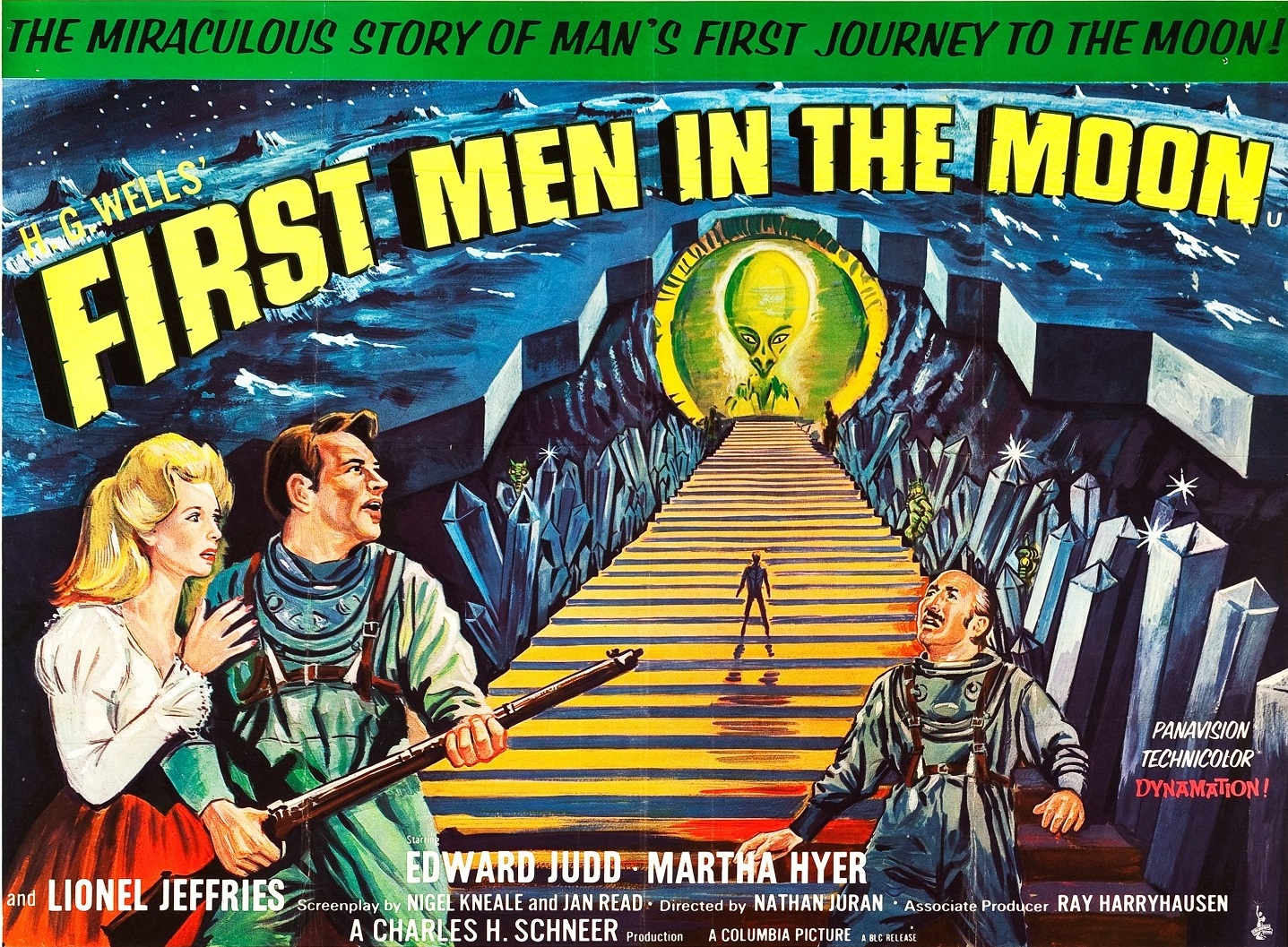
Yes! First Men in the Moon, to be factual and politically correct for the times, includes a woman too. They just left her out of the title back in 1964–something they wouldn’t dare do 75 years later, in 2021. More correctly today, it would be something gender neutral like First Humans in the Moon, or something more pretentious, albeit wordy, like First Men and a Woman in the Moon. As for correctness, there’s more. When I first saw the title for this one way back whenever, I thought to myself, “Why in the moon? Why not on the the moon?” But, after watching it last night for the first time, these astronauts are, indeed, in the moon! And what a treat it was to be in there with them, vicariously! Oh, the nostalgia…and why I waited so long to see this one, I’ll never know. Too many movies, too little time, perhaps. But, after a recommendation from a good friend and fellow lover of vintage sci-fi, I not only saw the movie but finally have it my collection. Amen…and a-woman too.” ~ Democratic Congressman Emanuel Cleaver, January 3, 2021
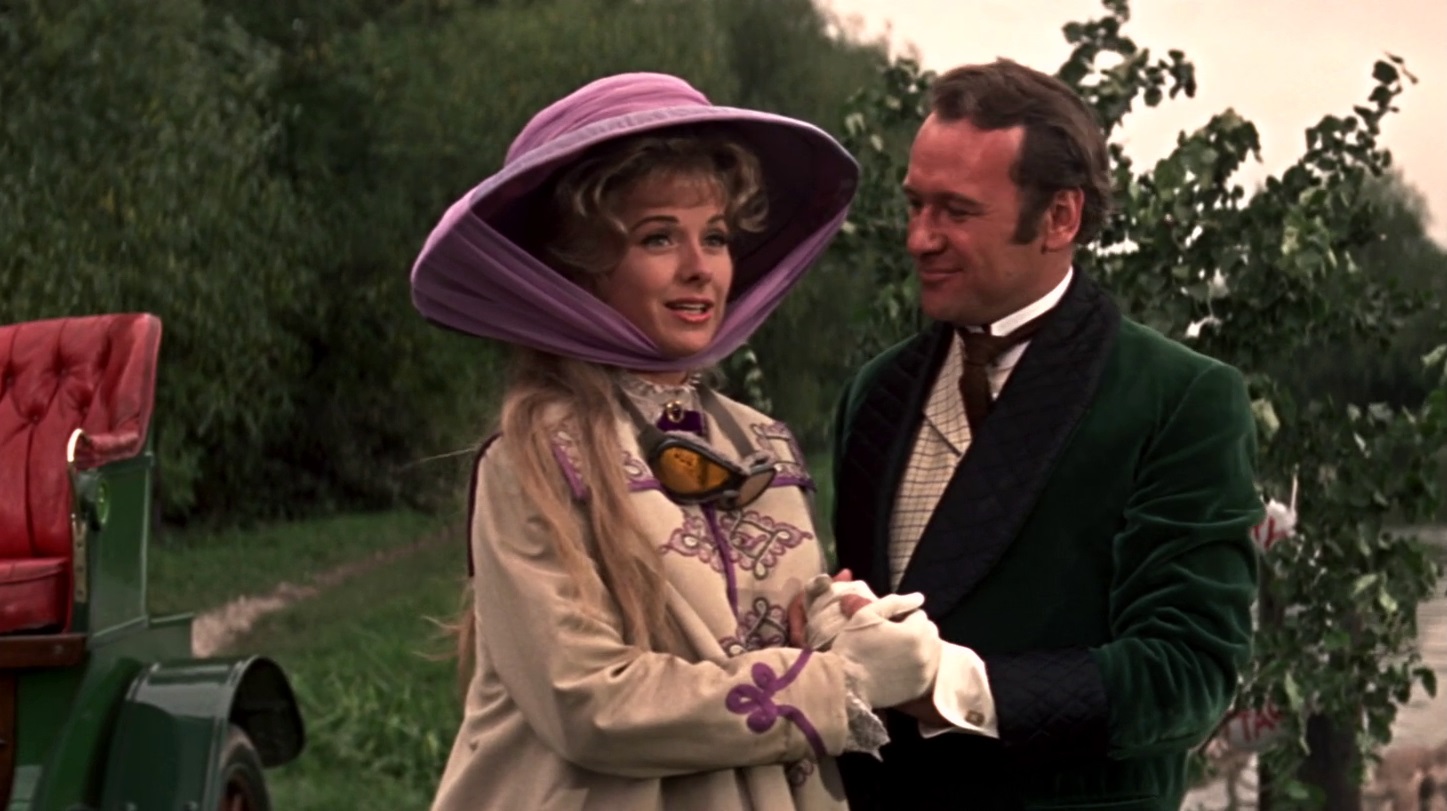
The lovely Kate Callender arrives at Cherry Cottage to see her fiancé, Arnold (Edward Judd)
The movie is based on a story by the famous H.G. Wells–a story I haven’t yet read. (And please forgive me for that.) Wells’ title, including the definite article “The” at the beginning, is actually The First Men in the Moon. Published in 1901 (with the story taking place in the same year), Wells, even as a visionary writer, could never have known how true to science his movie would be in the future…at least with the eventuality of humans going to the moon. The means of getting there (in a cavorite-coated sphere, literally crash landing and tumbling to a stop), as well as the indigenous lunar inhabitants, are of fiction never realized of course; but, as fantasy sci-fi, it doesn’t get any better…even with the few issues the movie certainly has.
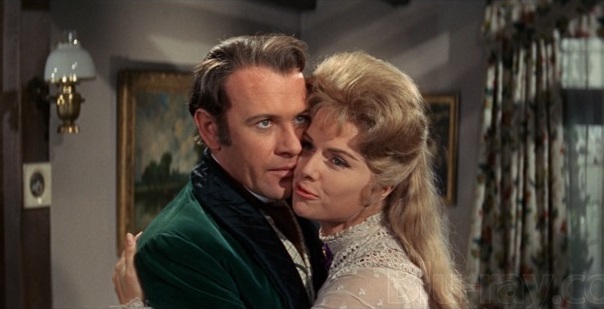
Arnold Bedford (the fiance fixated on profit) and the devoted, wannabe wife Kate Callender
As for issues, I was a bit put off, at first, by the movie’s unevenness. The first half of it, on Earth, is a comedy with over-the-top mishaps and calamities almost nonstop. Professor Josef Cavor (Lionel Jeffries) adds the frenetic mad scientist element that generates most of the humor, all the better with Jeffries being a true master of the art. On the moon, after a brief blunder caused by hyper oxygenation and low gravity, the movie is about as serious and deadpan as its sci-fi predecessors from the 50s, even preaching lessons to humans as warmongers and destroyers. While the humor is effective (and it made me laugh a lot), it took some time adjusting to the sudden shift and contrast. To use a space term, after I decompressed, I was okay with it, not only enjoying it, but loving it just as much.
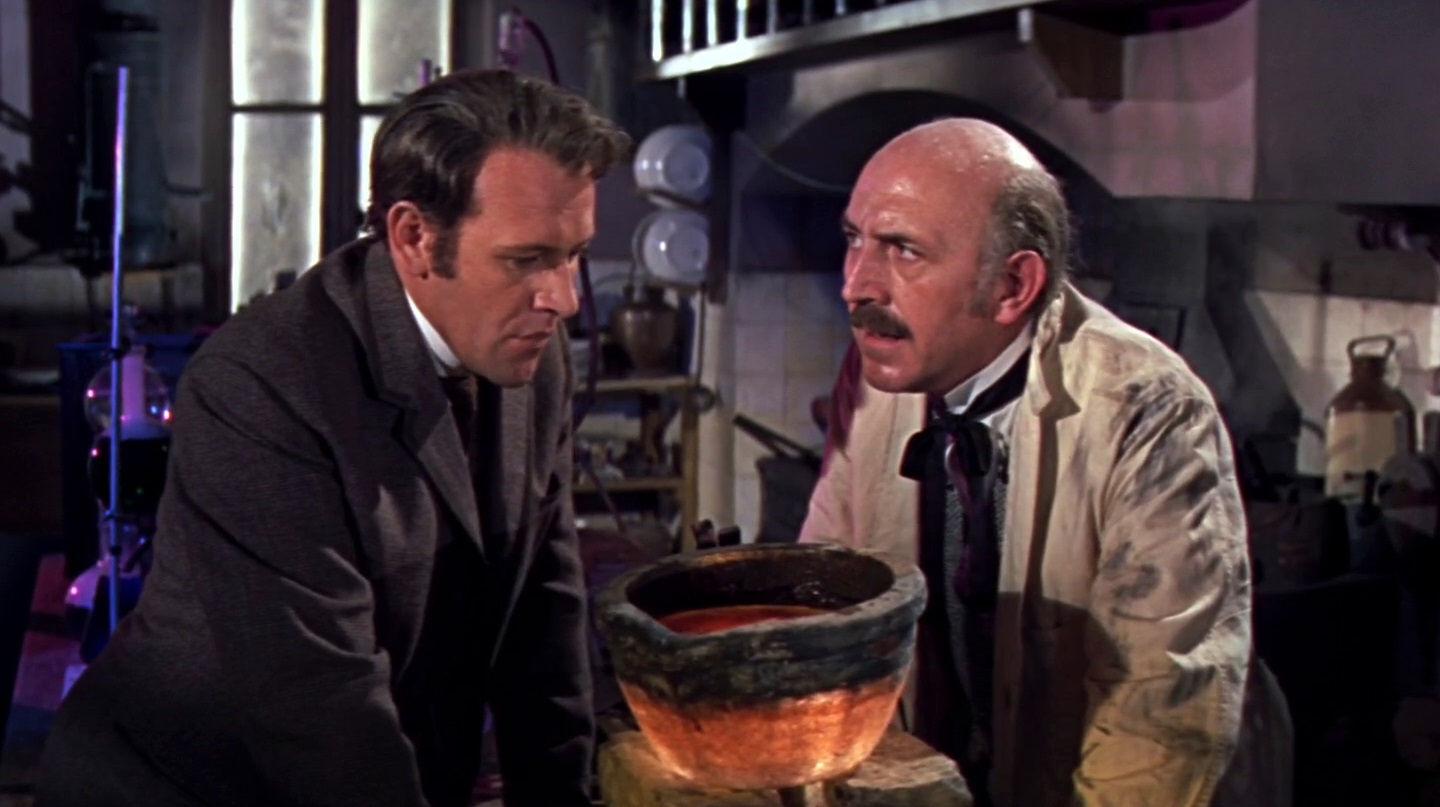
Arnold Bedford (Edward Judd) and Professor Cavor (Lionel Jeffries) with Cavorite!
The character of Arnold Bedford (Edward Judd) was another anomaly in the movie. While Judd’s acting is without reproach, his character was another uneven element. Although not atypical of some people in life, Arnold was mostly unlikeable, in a movie where I think he should have been more likeable. He intentionally gets his fiancé, Kate Callender (played by the lovely Martha Hyer), into legal trouble for his own expected financial gain, and he later he doesn’t care when she threatens to leave as a result. He is surprised when he finds out that she stayed, mostly thinking of her as further, unexpected opportunity….or so it seems. Arnold also later admits that he is not saving a certain person’s life for the noble sake of saving a life–again, he’s doing it just for personal gain, and he’s not afraid to admit it. (He can’t even pretend he would save a life selflessly, even given the opportunity to take credit.) What’s worse–probably even more for the politically-correct times we live in now, if not then–is that Arnold treats his fiancé mostly like a sexual object of convenience–if she’s there, I’ll take advantage of the opportunity; if not, my personal gain is too important to worry about her. But, politically correct or not, the truth is the truth; some men will be men, one way or the other.
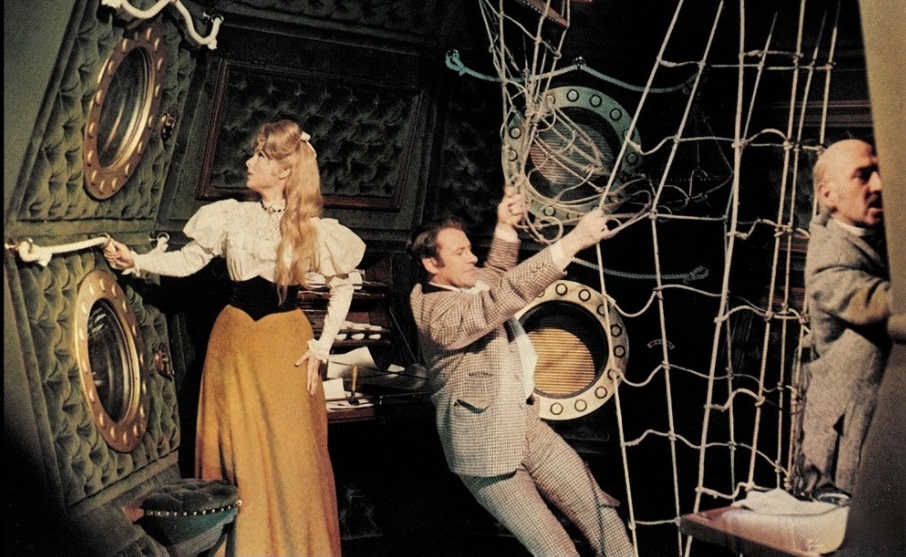
Ms. Callender, Arnold, and Professor Cavor inside the sphere, on the way to the Moon!
The character of Arnold Bedford is also unlikeable in how quickly he resorts to violence and killing, in dealing with the indigenous lunar creatures. Throwing them off cliffs, nearly a dozen at a time, before they’ve even hinted at their own intentions, makes Arnold possibly the worst ambassador for humanity in the history of sci-fi movies–albeit, perhaps, most honestly representing his species. His approach could be best summed up with a famous quote from General George S. Patton: “When in doubt, attack.” With this attitude, Arnold also gives any alien life form cause to fear humans and see us best exterminated. With this attitude, he is also, perhaps, from a politically-correct perspective, the ultimate extraterrestrial racist, murderous, supremacist-minded Victorian explorer.
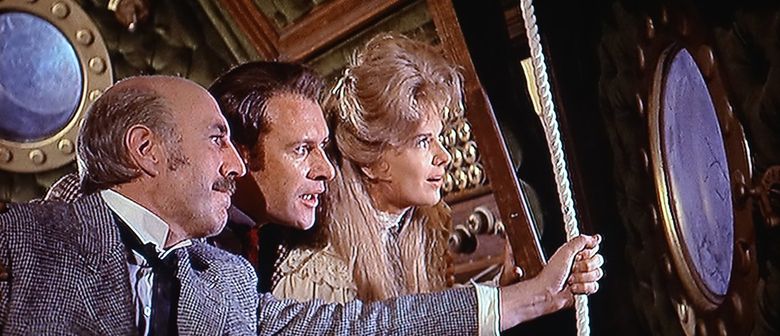
Oh how amazing it is, that world outside the window!
Did the uneven elements and politically-incorrect issues applied retroactively affect my love of First Men in the Moon? Of course not! While they exist for those who seek them out, and while I point them out mostly in jest, I am not one to be bothered by it. The humor worked, and while I wanted Arnold to be a nicer guy and treat Ms. Callender and the aliens with more respect, he was a very real and possible character for any time, in 1901 as much as in 2021. Unrequited outcomes and political perspectives of the future should not be the basis of disliking or discrediting such an otherwise wonderful film, and I won’t do it here. I’ll just settle for disliking Arnold Bedford. As for the title being all about “men,” don’t forget that a woman actually went to the moon with them, even if it happened by chance. If the men had only asked Ms. Callender to go, it would have been perfect…almost!
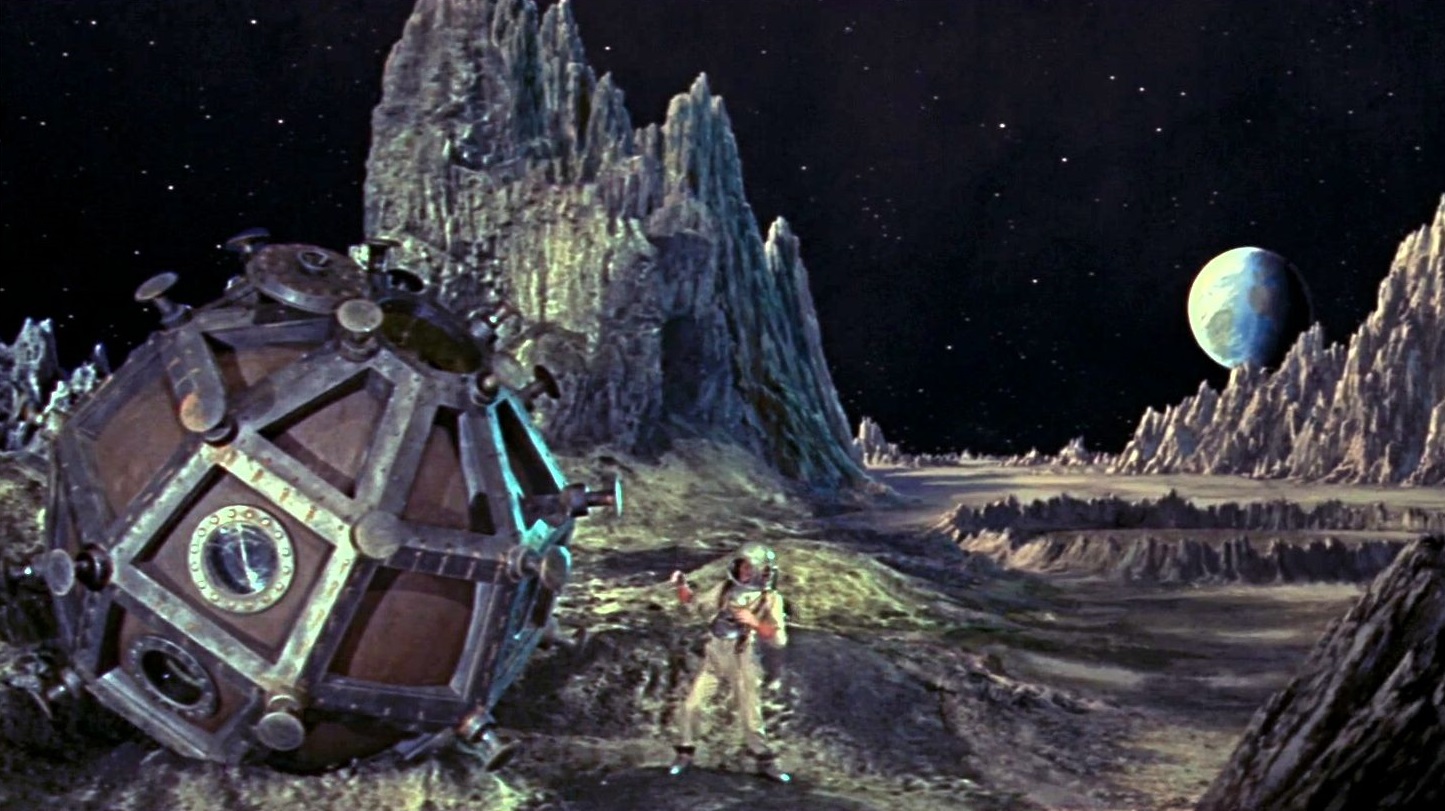
The sphere, tumbled to a stop, on the Moon!
Speaking more of Ms. Kate Callender, it was most interesting to see her as a beautiful, seemingly delicate woman, portrayed not as a damsel in distress looking for a man to save her. Instead, she’s a woman who’s headstrong and resourceful, able to defend herself, with foresight to plan on doing so on her own. It’s Kate’s idea to take an elephant gun to the moon, although chided by the men for doing so; and she doesn’t hesitate to use it herself, when necessary. (She must have dispatched at least several Selenites with it at once, in a particular scene.) There’s no man chasing behind, as her knight in shining armor ready to save her. While helpless women in other sci-fi movies of the day were being carried off by aliens and monsters galore, screaming or helpless in a coma, Kate is blowing them away on her own. So, in another way, yet closer to perfection, First Men in the Moon was politically correct before it’s time, back in 1964, before the alarm clock of uber feminism ever sounded.
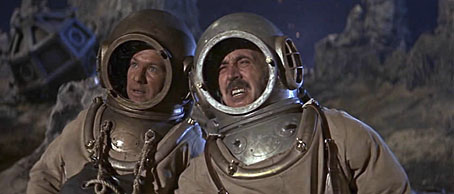
Arnold and Professor Cavor on the Moon
As for how much First Men in the Moon rings true with scientifically-correct reality, I won’t talk about the high altitude flight helmets used by astronauts in the story’s 1960s timeframe, before the flashback. I won’t talk about the deep-sea diving helmets and suits used for the lunar environment. I won’t talk about the storage bin Ms. Callender was put in to protect her from the lunar atmosphere. No, I won’t talk about that and a lot more, because this a sci-fi fantasy. That’s the fun of it, and anything goes. Check your brain at the door, butter the popcorn, and enjoy! (At least they thought of putting Ms. Callender in a storage bin to protect her; it could have been a lot worse!)
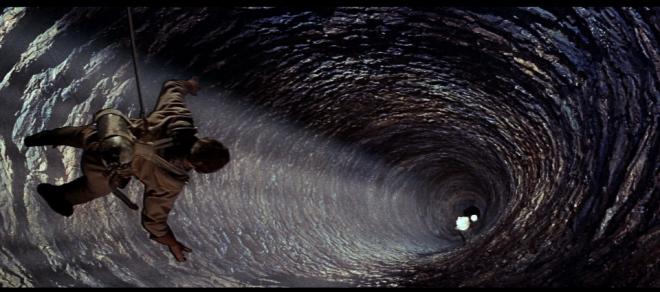
Like the movie’s title says, insdie the Moon we go!
As for apolitical highlights, there are many. I will talk about the creative genius of Ray Harryhausen and how he adds so much with his trademark Dynamation. His stop-motion animation is easily the best part of the movie for me. The large, caterpillar-like creatures nicknamed “Moon Cows,” and at least some of the Selenites, particularly the “Prime Lunar” Selenite in charge, are amazing period feats of animation, as expected. There’s just something delightfully nostalgic about it that never gets old, no matter how dated it may be. Like so many fans, my love of monsters from days gone by is die hard and true, and the magic of Harryhausen is the cherry on top! His labor-of-love to filmmaking shines through, embracing fans in every scene.
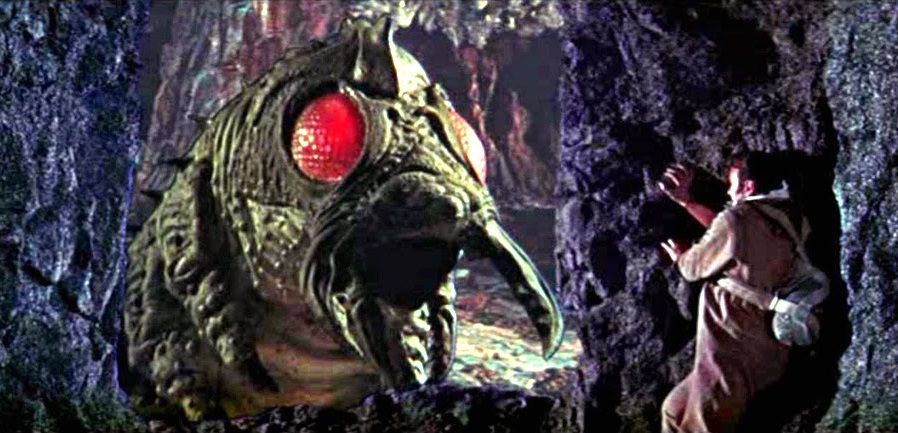
Ray Harryhausen’s “Moon Cow” attempts to make lunch of Arnold in First Men in the Moon
Although this is more of a retrospective piece than a review, I will not reveal the ending directly, although I will allude to it for analysis. (So if you haven’t seen the movie yet, you many want to skip the rest of this paragraph!) If the movie’s ending is true to the original story, H.G. Wells certainly has a thing for the consequences of microscopic life making contact with life elsewhere in the universe. It’s like a companion piece to The War of the Worlds, with man being the harbinger of microbial doom again, this time as an invader himself. The ending was actually far from predictable; its revelation as an apparent author motif was one of which I was not aware. And again, we are back to the ravages of man as a politically-incorrect meddler in the destiny of other cultures, and here, even alien races.
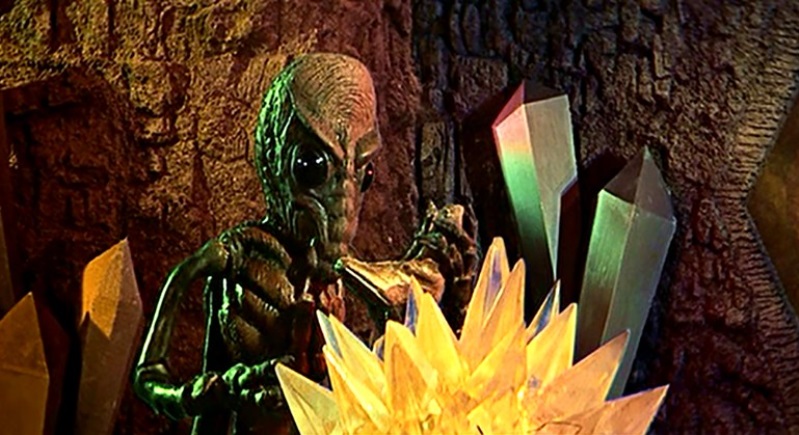
A Selenite (another Harryhausen creation)
In the end, is First Men in the Moon anymore politically incorrect than other films of its time? No. If anything, it’s actually more politically correct than other films. It’s actually more correct than many films from any time, even now. It’s just one that I chose somewhat randomly, also with a bit of intention, as a somewhat anomalous, ironic example of the topic. And a damn good choice it is!
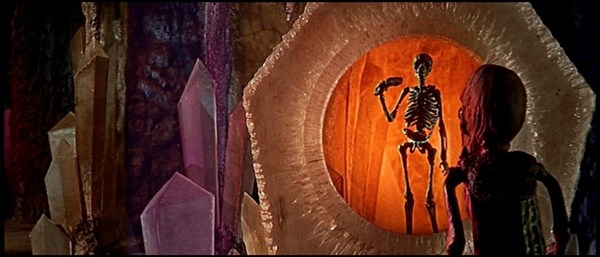
What would a Harryhausen film be without a Selenite observing the stop-motion animated skeleton of Ms. Callender (Yes! Fond memories of The 7th Voyage of Sinbad this gives me!)
If you choose to purchase the movie, there is currently only one choice to make. The Indicator bluray delivers the best transfer and most bonus-packed collection of special features anywhere to be found currently. The 4K restoration from the original negative is excellent, with reference-quality color saturation and no trace of artifacting or digital noise. (The black tones are crisp and static throughout.) Audio options include the original mono track, the original four-channel mix, as well as an alternate 5.1 surround track (the one I chose on my first viewing). And there is much more: audio commentary with Ray Harryhausen and Randall William Cook, moderated by film historian Tony Dalton; a Randall William Cook introduction (2012); Terry Schubert on First Men in the Moon (2017), where the special effects assistant remembers working with Ray Harryhausen, and much, much more! Along with additional interviews and featurettes are original trailers, soundtrack music, images of original lobby cards, promotional stills, posters, etc. Don’t be fooled into buying and older DVD for $50.00 on Ebay–the ones advertised as “out of print” collector’s items! The region-free Indicator disc is in current production, available for less than $20.00.
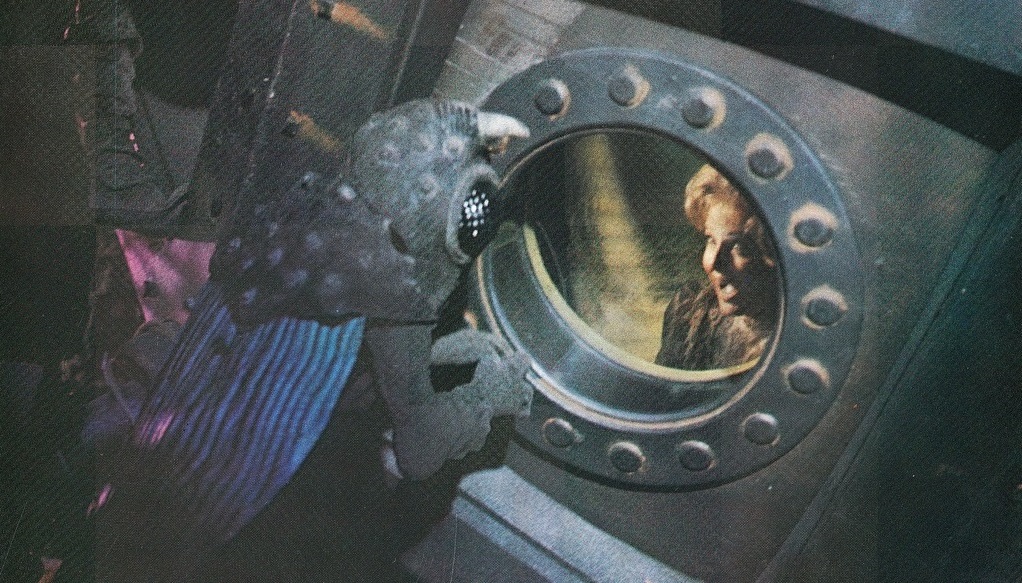
Yes! A Selenite has Ms. Callender screaming…but she has an elephant gun!
Since I’ve never read the H.G. Wells story upon which the movie is based, this is also not a book-to-film comparison. It’s just an off-the cuff critique of an oldie but a goodie I finally watched, thanks to a good friend. If you haven’t yet seen this should-be classic and definite gem of sci-fi romance, all aboard the cavorite-coated sphere! The First Men (and a Woman) in the Moon awaits! Tumble to a crash landing and explore the inner caverns of the rock that orbits us, in deep-sea diving suits, with an elephant gun in hand. With a woman toting an elephant gun, with an attitude to match, this is a retro-feminist classic underappreciated for its futuristic political content and value. Even Congressman Cleaver would like this one! Amen again…and a woman too, again!

Rocket Rating – 8
Chris Rennirt (the author of this article) is a movie critic and writer in Louisville, Kentucky, as well as editor in chief at Space Jockey Reviews. He has been a judge at many film festivals, including Macabre Faire Film Festival and Crimson Screen Film Fest, and he attends horror and sci-fi conventions often. Chris’ movie reviews, articles, and interviews are published regularly on Space Jockey Reviews and in Effective Magazine. His mission statement (describing his goals as a movie critic and philosophy for review writing) can be found on the “Mission” page, here at SJR. For more information about Chris Rennirt (including contact details, publicity photos, and more), click here.
You may also like these!









